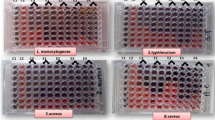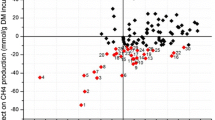Abstract
Ruminal proteolysis and subsequent amino acid degradation represent considerable economic loss in ruminant production. The hyper ammonia-producing bacteria (HAB) are largely responsible for amino acid deamination in the rumen. HAB can be controlled with ionophores, but they are also susceptible to antimicrobial plant secondary metabolites. Red clover (Trifolium pratense) is rich in soluble phenolics, and it is also more resistant to proteolysis than other legumes. The goal of this study was to identify phenolic compounds from Trifolium pratense cultivar Kenland, and determine if any of the compounds possessed antimicrobial activity against the bovine HAB, Clostridium sticklandii SR. HPLC analysis revealed that clover tissues were rich in the isoflavonoids formononetin and biochanin A, particularly in plants left to wilt for 24 h. Biochanin A inhibited C. sticklandii in bioassays that employed thin-layer chromatography (TLC). Both clover extracts and biochanin A inhibited the growth of C. sticklandii in broth culture, but formononetin had no effect. These results indicate that clover phenolic compounds may have a role in preventing amino acid fermentation.



Similar content being viewed by others
References
Andersen C, Nielsen TS, Purup S, Kristensen T, Eriksen J, Soegaard K, Sorensen J, Frette XC (2009) Phyto-oestrogens in herbage and milk from cows grazing white clover, red clover, lucerne or chicory-rich pastures. Animal 3:1189–1195
Attwood G, Li D, Pacheco D, Tavendale M (2006) Production of indolic compounds by rumen bacteria isolated from grazing ruminants. J Appl Microbiol 100:1261–1271
Bach A, Calsamiglia S, Stern M (2005) Nitrogen metabolism in the rumen. J Dairy Sci 88:E9–E21
Benchaar C, Petit H, Berthiaume R, Whyte T, Chouinard P (2006) Effects of addition of essential oils and monensin premix on digestion, ruminal fermentation, milk production, and milk composition in dairy cows. J Dairy Sci 89:4352–4364
Bittner S (2006) When quinones meet amino acids: chemical, physical and biological consequences. Amino Acids 30:205–224
Bryskier A (ed) (2005) Antimicrobial agents: antibacterials and antifugals. ASM, Washington DC
Chaney AL, Marbach EP (1962) Modified reagents for determination of urea and ammonia. Clin Chem 8:130–132
Chen GJ, Russell JB (1989) More monensin-sensitive, ammonia-producing bacteria from the rumen. Appl Environ Microbiol 55:1052–1057
Chesson A, Stewart C, Wallace R (1982) Influence of plant phenolic acids on growth and cellulolytic activity of rumen bacteria. Appl Environ Microbiol 44:597–603
Creelman RA, Tierney ML, Mullet JE (1992) Jasmonic acid/methyl jasmonate accumulate in wounded soybean hypocotyls and modulate wound gene expression. Proc Natl Acad Sci USA 89:4938–4941
Deavours BE, Dixon RA (2005) Metabolic engineering of isoflavonoid biosynthesis in alfalfa. Plant Physiol 138:2245–2259
Dickinson JM, Smith GR, Randel RD, Pemberton IJ (1988) In vitro metabolism of formononetin and biochanin A in bovine rumen fluid. J Anim Sci 66:1969–1973
El-Shazly K (1952) Degradation of protein in the rumen of the sheep II. The action of rumen micro-organisms on amino acids. Biochem J 51:647–653
Evans J, Martin S (2000) Effects of thymol on ruminal microorganisms. Curr Microbiol 41:336–340
Farag MA, Huhman DV, Dixon RA, Sumner LW (2008) Metabolomics reveals novel pathways and differential mechanistic and elicitor-specific responses in phenylpropanoid and isoflavonoid biosynthesis in Medicago truncatula cell cultures. Plant Physiol 146:387–402
Flythe MD (2009) The antimicrobial effects of hops (Humulus lupulus L.) on ruminal hyper ammonia-producing bacteria. Lett Appl Microbiol 118:242–248
Flythe MD, Andries K (2009) The effects of monensin on amino acid catabolizing bacteria isolated from the Boer goat rumen. Small Rum Res 81:178–181
Guggolz J, Bickoff EM, Livingston AL (1961) Forage estrogens—detection of daidzein, formononetin, genistein, and biochanin A in forages. J Agr Food Chem 9:330–332
Hungate RE (1947) Studies on cellulose fermentation: III. The culture and isolation for cellulose-decomposing bacteria from the rumen of cattle. J Bacteriol 53:631–645
Jones B, Muck R, Hatfield R (1995) Red clover extracts inhibit legume proteolysis. J Sci Food Agric 67:329–333
Krause DO, Russell JB (1996) An rRNA approach for assessing the role of obligate amino acid-fermenting bacteria in ruminal amino acid deamination. Appl Environ Microbiol 62:815–821
Lee MRF, Winters AL, Scollan NG, Dewhurst RJ, Theodorou MK, Minchin FR (2004) Plant-mediated lipolysis and proteolysis in red clover with different polyphenol oxidase activities. J Sci Food Agric 84:1639–1645
Lowry OH, Rosenbough NJ, Farr AL, Randall RJ (1951) Protein measurement with the folin phenol reagent. J Biol Chem 193:265–275
Lund BM, Lyon GD (1975) Detection of inhibitors of Erwinia carotovora and E. herbicola on thin-layer chromatograms. J Chromatogr 110:193–196
Mattila P, Kumulainen J (2002) Determination of free and total phenolic acids in plant-derived foods by HPLC with diode-array detection. J Agric Food Chem 50:3660–3667
Morel C, Stermitz FR, Tegos G, Lewis K (2003) Isoflavones as potentiators of antibacterial activity. J Agr Food Chem 51:5677–5679
Nicholson RL, Hammerschmidt R (1992) Phenolic-compounds and their role in disease resistance. Annu Rev Phytopathol 30:369–389
Paster BJ, Russell JB, Yang CM, Chow JM, Woese CR, Tanner R (1993) Phylogeny of the ammonia-producing ruminal bacteria Peptostreptococcus anaerobius, Clostridium sticklandii, and Clostridium aminophilum sp. nov. Int J Syst Bacteriol 43:107–110
Polan C (1988) Update: dietary protein and microbial protein contribution. J Nutr 118:242–248
Russell JB, Houlihan AJ (2003) Ionophore resistance of ruminal bacteria and its potential impact on human health. FEMS Microbiol Rev 27:65–74
Russell JB, Strobel HJ, Chen GJ (1988) Enrichment and isolation of a ruminal bacterium with a very high specific activity of ammonia production. Appl Environ Microbiol 54:872–877
Rychlik JL, Russell JB (2002) Bacteriocin-like activity of Butyrivibrio fibrisolvens JL5 and its effect on other ruminal bacteria and ammonia production. Appl Environ Microbiol 86:1040–1046
Sakakibara H, Honda Y, Nakagawa S, Ashida H, Kanazawa K (2003) Simultaneous determination of all polyphenols in vegetables, fruits, and teas. J Agr Food Chem 51:571–581
Sullivan ML (2009) A novel red clover hydroxycinnamoyl transferase has enzymatic activities consistent with a role in phaselic acid biosynthesis. Plant Physiol 150:1866–1879
Sullivan ML, Hatfield RD (2006) Polyphenol oxidase and o-diphenols inhibit postharvest proteolysis in red clover and alfalfa. Crop Sci 46:662–670
Sullivan ML, Hatfield RD, Thoma SL, Samac DA (2004) Cloning and characterization of red clover polyphenol oxidase cDNAs and expression of active protein in Escherichia coli and transgenic alfalfa. Plant Physiol 136:3234–3244
Towers GHN (1964) Metabolism of phenolics in higher plants and micro-organisms. In: Harborne JB (ed) Biochemistry of phenolic compounds. Academic Press, New York, pp 249–294
Van Nevel CJ, Demeyer DI (1977) Effect of monensin on rumen metabolism in vitro. Appl Environ Microbiol 34:251–257
Varel V, Jung J (1986) Influence of forage phenolics on ruminal fibrolytic bacteria and in vitro fiber degradation. Appl Environ Microbiol 52:275–280
Wallace RJ, McKain N, McEwan NR, Miyagawa E, Chaudhary LC, King TP, Walker ND, Apajalahti JHA, Newbold CJ (2003) Eubacterium pyruvativorans sp. nov., a novel non-saccharolytic anaerobe from the rumen that ferments pyruvate and amino acids, forms caproate and utilizes acetate and propionate. Int J Syst Evol Microbiol 53:965–970
Wells J, Berry E, Varel V (2005) Effects of common forage phenolic acids on Escherichia coli O157:H7 viability in bovine feces. Appl Environ Microbiol 71:7974–7979
Winters AL, Minchin FR, Michaelson-Yeates TPT, Lee MRF, Morris P (2008) Latent and active polyphenol oxidase (PPO) in red clover (Trifolium pratense) and use of a low PPO mutant to study the role of PPO in proteolysis reduction. J Agr Food Chem 56:2817–2824
Wu Q, Wang M, Simon JE (2003) Determination of isoflavones in red clover and related species by high-performance liquid chromatography combined with ultraviolet and mass spectrometric detection. J Chromatogr A 1016:195–209
Xavier B, Russell J (2009) The ability of non-bacteriocin producing Streptococcus bovis strains to bind and transfer bovicin HC5 to other sensitive bacteria. Anaerobe 15:168–172
Zheng J, Ramirez V (2000) Inhibition of mitochondrial proton FOF1-ATPase/ATP synthase by polyphenolic phytochemicals. Brit J Pharmacol 130:1115–1123
Acknowledgments
We thank Dr. Norman L. Taylor (University of Kentucky, Department of Plant and Soil Science) for providing access to the clover plots used in this study, and for helpful discussions. This study was funded by the United States Department of Agriculture, Agricultural Research Service.
Disclaimer
“Proprietary or brand names are necessary to report factually on available data; however, the USDA neither guarantees nor warrants the standard of the product, and the use of the name by the USDA implies no approval of the product, nor exclusion of others that may be suitable.”
Author information
Authors and Affiliations
Corresponding author
Rights and permissions
About this article
Cite this article
Flythe, M., Kagan, I. Antimicrobial Effect of Red Clover (Trifolium pratense) Phenolic Extract on the Ruminal Hyper Ammonia-Producing Bacterium, Clostridium sticklandii . Curr Microbiol 61, 125–131 (2010). https://doi.org/10.1007/s00284-010-9586-5
Received:
Accepted:
Published:
Issue Date:
DOI: https://doi.org/10.1007/s00284-010-9586-5




